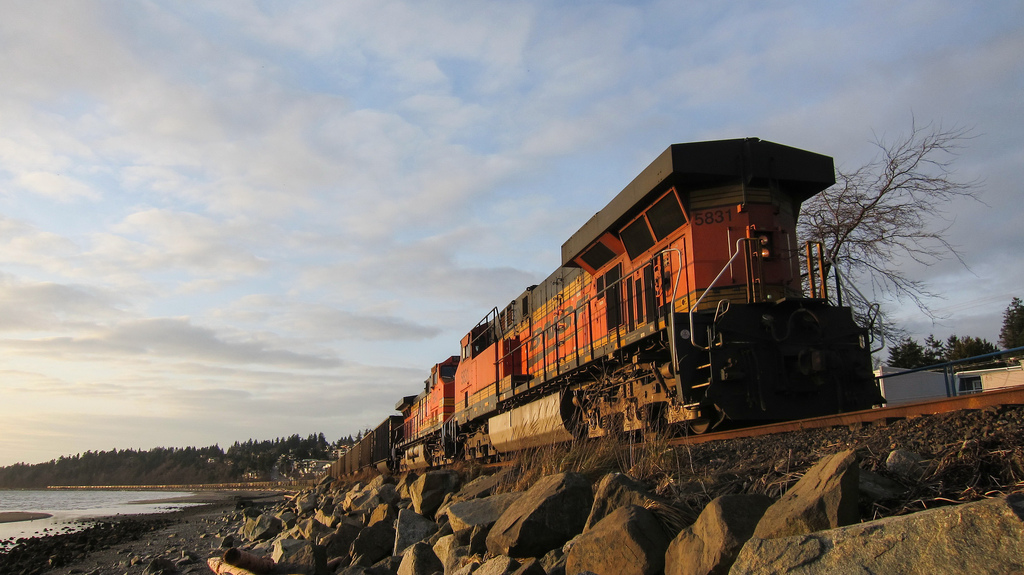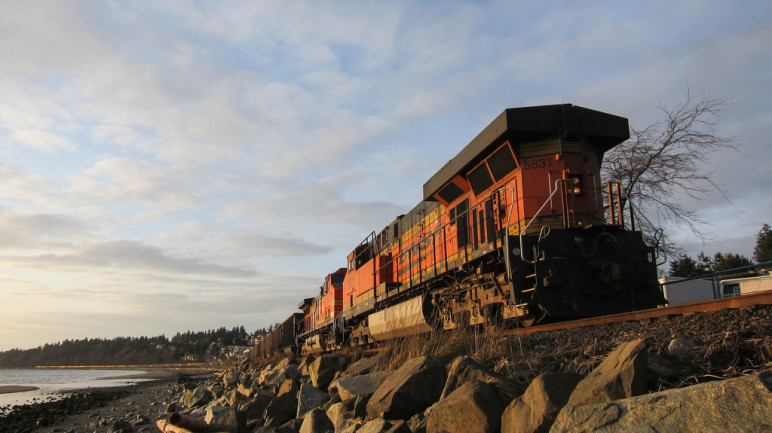In 2016, the debate over Northwest coal exports will heat up again. Of the six projects originally targeted for Oregon and Washington, all but two have died. And these two—terminals that would be the first and second largest in North America—will come up for public review this year when the government agencies reviewing them will publish Draft Environmental Impact Statements.
These documents are the first opportunity for the public to see a thorough analysis of the projects’ impacts. Their publication is followed by a period that allows members of the public to weigh in with comments that the reviewers are obligated to respond to. So in preparation for those reviews, here is what you need to know about the current state of Northwest coal export schemes.
Millennium Bulk Terminals (Longview, Washington)
A proposal to export 44 million metric tons of coal annually from a site on the Columbia River, Millennium Bulk Terminals would be the biggest coal terminal in North America (second only to the project planned for Whatcom County). It has also been intensely controversial—so much so, in fact, that the government agencies reviewing the project were swamped with 215,000 public comments during the “scoping” phase of the review. Washington regulators subsequently decided to look at the local and global effects of burning coal among many other dimensions of the state’s review, which will be conducted jointly with Cowlitz County.
Scope of government reviews
The Washington Department of Ecology anticipates that the state and Cowlitz County will publish a joint Draft Environmental Impact Statement (DEIS) on April 30, to be followed by a minimum of 21 days of public comment. Originally slated for release in November 2015, officials extended the deadline to allow for more study of a) the risk of vessel incidents on the Columbia River owing to an increase in marine traffic, b) impacts to vehicle traffic during peak travel times, and c) consequences of increased rail traffic through Longview’s industrial corridor. Cowlitz County defined its interests in the review to include greenhouse gas pollution from the project itself resulting from the ensuing coal combustion plus rail and coal dust impacts within the county’s jurisdiction. Ecology added in-state and out-of-state rail impacts and marine vessel transportation. The State/County DEIS will also include a “Health Impact Assessment” that will examine air quality implications, noise and vibration impacts, and public safety threats and mobility impacts near the site.
The US Army Corps of Engineers is conducting a separate review of the project on behalf of the federal government. That agency is expected to publish its DEIS for Millennium Bulk Terminals in July 2016. After the DEIS and public comment period of at least 45 days, the government will issue a Final EIS, although no date has yet been announced. The Final EIS will include revisions based on and responses to the comments submitted on the Draft, and it is intended to inform federal agencies’ subsequent decisions about issuing permits.
Want more? Here's how Northwest communities have stopped coal export projects.
Permit decisions
After the county review is complete, Cowlitz County will decide whether to issue development permits for the site. Two state agencies will also decide whether to issue permits: The Washington Department of Ecology exercises jurisdiction of a Water Quality Certification that the project needs, while the state’s Department of Natural Resources is responsible for issuing a lease for state-owned aquatic lands at the site, as well as other permits. Finally, the Army Corps must determine whether the proposal complies with federal laws and determine whether the development requires any mitigation.
Additional challenges to the project
Even barring trouble with environmental reviews and permitting, there is reason to think that the project may no longer be financially viable. Ambre Energy, the initial project backer, had hoped to begin operations by mid-2014, but that date has moved well into 2017 at the earliest. In the meantime, a series of financial reversals resulted in Ambre selling its North American assets to its creditor, a risk-hungry private equity firm called Resource Capital Funds that has renamed the company Lighthouse Resources. Meanwhile, the project’s minority backer, Arch Coal, has seen its fortunes deteriorate so precipitously that it recently collapsed into bankruptcy.
Gateway Pacific Terminal (Ferndale, Washington)
Project backer SSA Marine has plans to build a 48 million ton per year coal export terminal on the shores of Puget Sound in northern Whatcom County. It would be the largest coal terminal in North America, and the project is arguably the single most hotly contested fossil fuel infrastructure proposal in the Northwest.
Scope of government reviews
The government agencies reviewing the project are on independent tracks, with the US Army Corps of Engineers conducting one DEIS while the Washington Department of Ecology, in partnership with Whatcom County, conducts a more comprehensive DEIS analysis. Both DEIS documents are expected to be released in late 2016, followed by hearings and a comment period of at least 45 days.
The Gateway Pacific Terminal would be the largest coal terminal in North America.
Key issues that may be identified in both Statements are coal dust particulate matter and greenhouse gas pollution modeling, which were added as additional scope items echoing public input. In addition, Ecology’s analysis will account for many further impacts of the Gateway Pacific Terminal, including rail traffic and diesel exhaust from the 16 additional trains that would traverse the state each day, risks of increased marine vessel traffic, and burdens on public services like police, fire, and EMS. In addition, Ecology has already flagged wetland and water quality violations by the project.
Permit decisions
After the environmental review process is complete, estimated to be late 2017 at the earliest, the project will still require an array of permits that will be detailed in the final EIS. From the State, project backers will need an Aquatic Lands Lease from the Department of Natural Resources and State Lands Commissioner, along with Water Quality Certification, National Pollutant Discharge Elimination System, and Coastal Zone Management Certifications from the Department of Ecology. From the feds, the Army Corps of Engineers will need to coordinate a Record of Decision on federal interests, such as discharge and dredging or fill, and other relevant laws, including the Endangered Species Act.
Whatcom County also will have its say over Major Development and Shoreline Substantial Development permits, among others, representing a potentially serious obstacle to the project. The current majority of the Whatcom County Council is supported by environmental advocates who are against the terminal, although four of the seven members will be up for election in fall 2017. Competing ballot measures to amend how the County Council is elected were approved by voters in fall 2015 and may impact the Council’s makeup, depending on how a bipartisan committee draws the new voting boundaries.
Additional challenges to the project
The project proposal has been plagued by troubles. Among the most serious is the Lummi Nation’s demand that the US Army Corps deny the permit application because it endangers the tribe’s treaty-protected fishing rights. The Swinomish and Tulalip Tribes have sent similar letters in support of the Lummi. The project is proposed in a state aquatic reserve and in treaty-protected fishing areas of five Washington Tribes. It also overlaps Xwe’chi’eXen, a Lummi village site and ancestral cemetery.
The Corps’ DEIS will determine whether the project poses more than a minor (de minimis) disruption to the tribe’s treaty-protected fishing rights. There’s also a chance that the determination will be revealed sooner than the DEIS, and it could trigger a denial of the project. The stakes are so high for would-be coal exporters that in December 2015, the US House of Representatives passed an energy bill with an amendment by Representative Zinke, a republication from Montana, that stipulates that federal permits for projects like Gateway may not be denied until the agencies have completed all the required reviews. The amendment directly targeted the Lummi’s request to the Corps for an immediate halt to the review process.
The companies behind the terminal have made some recent adjustments to try to head off challenges by the Lummi. In December 2015, the project backers resubmitted to the Corps a revised Joint Aquatic Resources Permit Application, originally filed in 2011, with an updated site layout, port operations, and safety plan, and an updated boundary that sets aside an additional 300 acres for wetlands. They also included wetland mitigation plans and measures, believed by observers to be an attempt to forestall a finding of disruption to tribal fishing protected areas.
The Millennium Bulk and Gateway Pacific Terminals Draft Environmental Impact Statements are the last official public comment opportunities on these projects. They may become the tombstones for new coal export terminals in the Northwest given the Thin Green Line’s turnout during the scoping periods and recent success delaying or ending fossil fuel export projects in Tacoma and Longview.
Read more: A torrent of terrible news for coal exports continues.













kristi
Please help preserve Salish Sea Area, it is so worth it. NO COAL EXPORT TERMINAL !!!